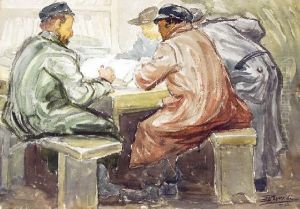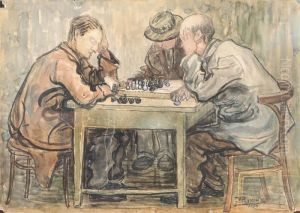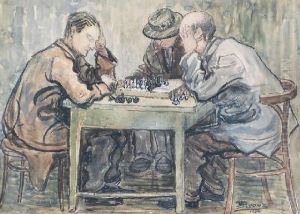Mojzesz Rynecki Paintings
Mojzesz Rynecki was a Polish-Jewish painter best known for his depictions of the Polish-Jewish community before World War II. Born on May 18, 1881, in Warsaw, which was then part of the Russian Empire, Rynecki grew up in a Jewish neighborhood that provided much of the subject matter for his later works. He was largely a self-taught artist, though he eventually attended the Warsaw School of Fine Arts, where he honed his skills and began to develop his distinct style.
Rynecki's artistic oeuvre is characterized by its focus on the daily life of Polish Jews. His paintings often depicted scenes from the markets, synagogues, study houses, and streets of Jewish quarters, capturing the vibrancy and cultural richness of his community. He was particularly adept at using color and light to evoke mood and atmosphere, imbuing his works with a sense of authenticity and immediacy.
Throughout the 1920s and 1930s, Rynecki exhibited his work in Warsaw and was an active member of the city's artistic community. However, his career was tragically cut short by the outbreak of World War II and the subsequent persecution of Jews by Nazi Germany. With the invasion of Poland in 1939, Rynecki's life and art were put in grave danger. Anticipating the worst, he made the decision to hide his paintings, dividing them into bundles that he placed in the care of friends for safekeeping.
During the war, Rynecki was confined to the Warsaw Ghetto, and in 1943, he was deported to the Majdanek concentration camp. His exact date of death is uncertain, but he is believed to have perished in the Holocaust that same year. The majority of his works were lost or destroyed during the war, but approximately 100 paintings survived, having been safeguarded by those who honored his legacy.
Today, Mojzesz Rynecki's surviving paintings are considered important historical documents, as well as significant contributions to the art of the interwar period. They offer a poignant window into the world of Polish Jewry that was largely obliterated during the Holocaust. His grandson, George Rynecki, has dedicated much effort to locating and documenting the lost works of his grandfather, an endeavor that speaks to the enduring impact of Mojzesz Rynecki's art and the ongoing quest to preserve the cultural heritage it represents.


